Heterocrossa philpotti is a moth of the family Carposinidae. It is endemic to New Zealand. The subspecies H. philpotti hudsoni has been recorded as being observed in Albany, Auckland. Alan W. Emmerson and Robert J.B. Hoare have hypothesised that there may be two species confused within this name.

Pasiphila bilineolata is a moth in the family Geometridae. It is endemic to New Zealand and can be found in the North and South Islands. The species inhabits native forest and shrubland and the larvae feed on Hebe species. Adults are on the wing commonly from August to January but have been observed most months of the year and are attracted to light.
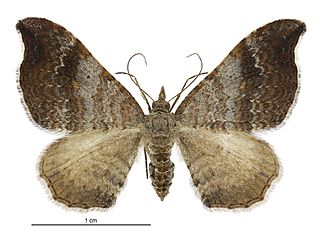
Homodotis megaspilata, also known as the small hooked-tip looper moth, is a moth of the family Geometridae. It is endemic to New Zealand and can be found throughout the country. It is regarded as being common species. The preferred habitat of this species is native forest, scrub, coastal areas and domestic gardens. Larvae feed on the dead leaves of Geniostoma ligustrifolium and likely other native plants. Once mature the larvae will pupate on the ground forming a silken cocoon protected by hiding inside two leaves of its host plant. Adults are nocturnal and are on the wing from October to April. They are attracted to light. In appearance the adults of this species are extremely variable but can be distinguished from similar species as all variations have forewings with blunt hook shaped tips.
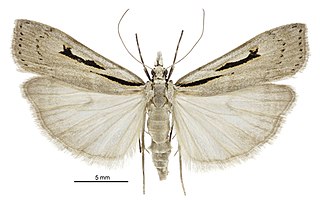
Scoparia rotuella is a species of moth in the family Crambidae. It was described by Cajetan Felder, Rudolf Felder and Alois Friedrich Rogenhofer in 1875 under the name Crambus rotuellus. In 1913 Edward Meyrick revised the taxonomy of the species and placed it within the genus Scopaira. It is endemic to New Zealand. Adults of this species have been shown to pollinate Helichrysum selago and Veronica salicifolia.

Arctesthes catapyrrha is a moth of the family Geometridae. It is endemic to New Zealand.
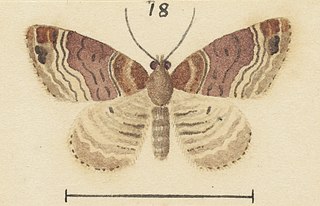
Hydriomena iolanthe is a species of moth in the family Geometridae. It is indigenous to New Zealand. This species is based on a single specimen that is now lost and has not been matched to any known species. As such it is classified as data deficient by the Department of Conservation.

Asaphodes clarata is a species of moth in the family Geometridae. This species is endemic to New Zealand and has been found on the North and South Islands. The species inhabits open grassy areas, including tussock grasslands, in montane habitat. The larvae feed on the leaves of Ranunculus species. The adult moths are day flying and are on the wing from December to February and have been shown to pollinate Celmisia laricifolia and Hebe pinguifolia.

Notoreas mechanitis is a species of moth in the family Geometridae. It is endemic to New Zealand.

Ichneutica disjungens is a moth of the family Noctuidae. This species is endemic to New Zealand and can be found on the central volcanic plateau of the North Island and in the eastern as well as the south western parts of the South Island. I. disjungens inhabits tussock grasslands in the alpine and subalpine zones. The hosts of the larvae of this species include Poa cita, P. colensoi, Festuca novae-zelandiae and Dracophyllum acerosum. The adults of this species are distinctive and are unlikely to be confused with other species. They are on the wing between October and March.
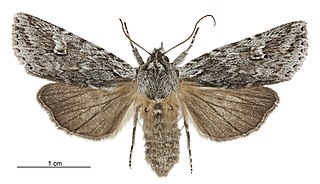
Physetica sequens is a species of moth of the family Noctuidae. It is endemic to New Zealand and can be found throughout the North and South Islands. It appears to be more common in the North Island than the South Island, and lives in open native shrublands, peatlands, Northland gumland, inland volcanic dunes, and Dracophyllum-dominated areas at altitudes that range from sea level to the alpine zone, up to at least 1600 m. Larvae of this species have been successfully reared on Leucopogon fasciculatus and Leptecophylla juniperina. The adults of this species are variable in appearance and are on the wing from September to March. P. sequens is similar in appearance to P. phricias but can be distinguished as P. phricias has a narrow black line along the dorsum of its forewing that P. sequens does not. P. sequens is also similar in appearance to P. cucullina however the forewing dorsum area of P. sequens does not have the narrow black line that is frequently present on P. cucullina forewings.

Austrocidaria callichlora is a species of moth of the family Geometridae. It endemic to New Zealand. It was first described by Arthur Gardiner Butler in 1879 and named Cidaria callichlora.
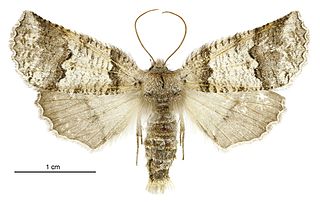
Declana feredayi is a species of moth in the family Geometridae. It is endemic to New Zealand. Adults of this species pollinate Hoheria Iyallii.
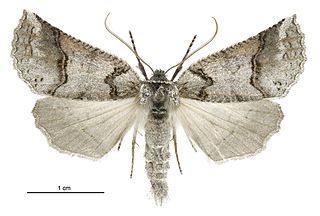
Declana junctilinea is a species of moth in the family Geometridae. It is endemic to New Zealand. Adults of this species pollinate Dracophyllum acerosum and Leptospermum scoparium.
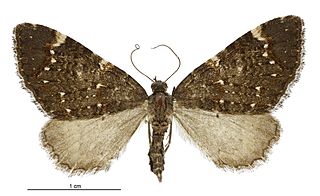
Hydriomena arida is a species of moth in the family Geometridae. This species is endemic to New Zealand. It has been hypothesised that species belongs to another genus and so this species is also currently known as Hydriomena (s.l.) arida.

Hydriomena canescens is a species of moth in the family Geometridae. It was first described by Alfred Philpott in 1918. This species is endemic to New Zealand. The classification of New Zealand endemic moths within the genus Hydriomena is regarded as unsatisfactory and in need of revision. As such this species is currently also known as Hydriomena (s.l.) canescens.
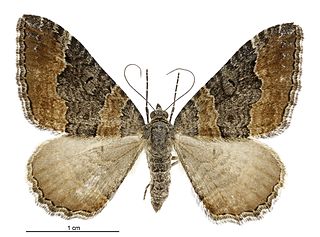
Hydriomena deltoidata is a species of moth in the family Geometridae. It was first described by Francis Walker in 1862. This species is endemic to New Zealand. The classification of New Zealand endemic moths within the genus Hydriomena is regarded as unsatisfactory and in need of revision. As such this species is currently also known as Hydriomena (s.l.) deltoidata. The adults of this moth are known to pollinate Dracophyllum acerosum and Leptospermum scoparium.
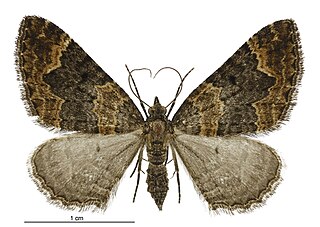
Hydriomena hemizona is a species of moth in the family Geometridae. It was first described by Edward Meyrick in 1897. This species is endemic to New Zealand. The classification of New Zealand endemic moths within the genus Hydriomena is regarded as unsatisfactory and in need of revision. As such this species is currently also known as Hydriomena (s.l.) hemizona.
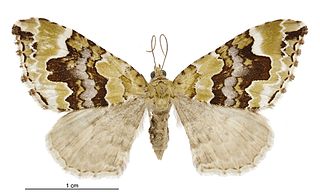
Hydriomena purpurifera is a species of moth in the family Geometridae. It was first described by Richard William Fereday in 1883. This species is endemic to New Zealand. The classification of New Zealand endemic moths within the genus Hydriomena is regarded as unsatisfactory and in need of revision. As such this species is currently also known as Hydriomena (s.l.) purpurifera.
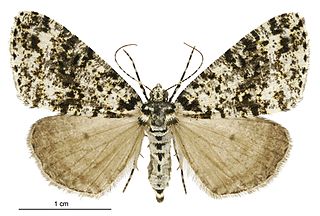
Pseudocoremia monacha is a species of moth in the family Geometridae. It is endemic to New Zealand. Adults of this species pollinate Veronica salicifolia.

Sestra flexata is a species of moth in the family Geometridae. This species is endemic to New Zealand. Adults of this species pollinate Leptospermum scoparium.




















